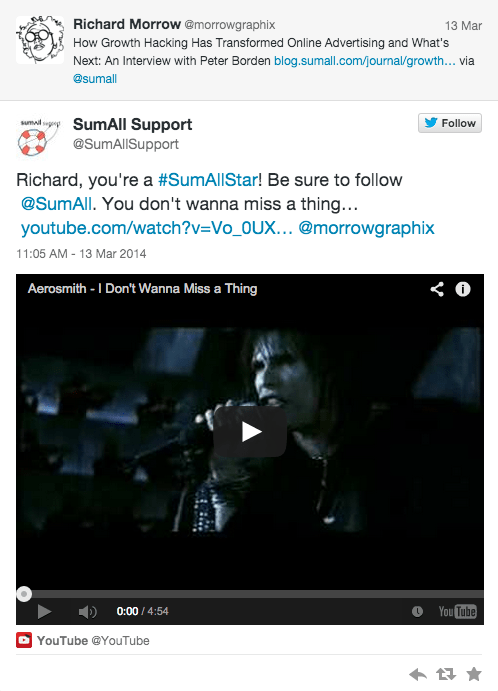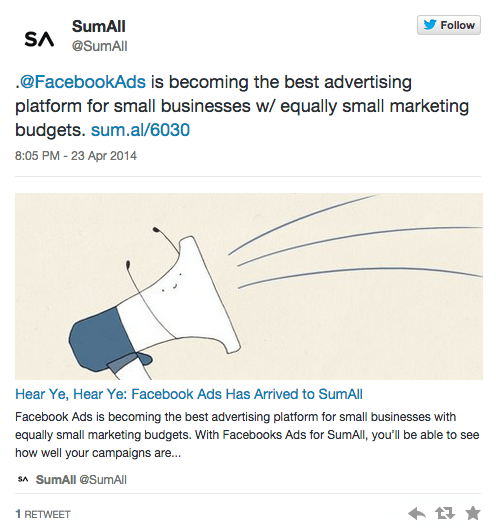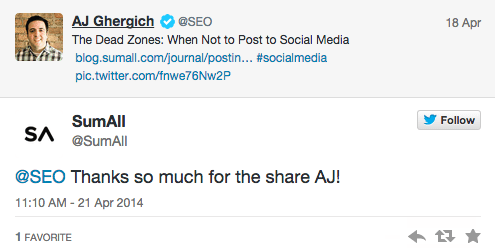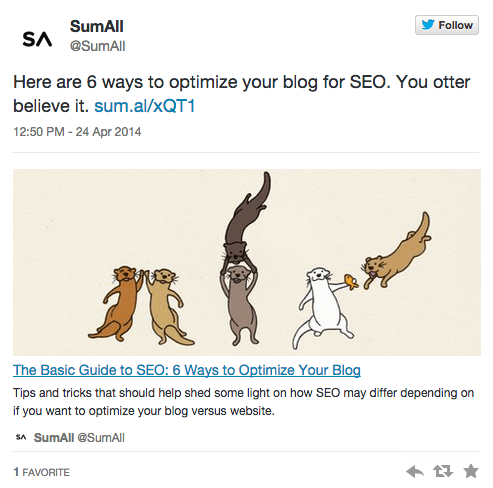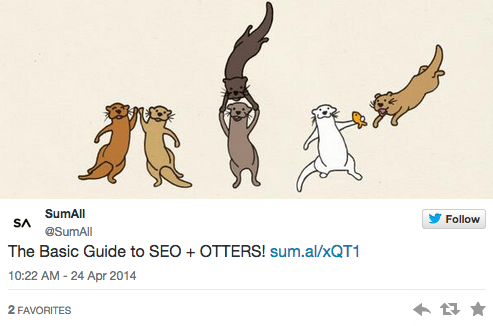We use Twitter primarily to engage with our audience in the three major ways listed below. Before you use Twitter for your business, you might want to ask, “Who is our audience?” For us, they range from marketers and social media enthusiasts that read our blog, to SumAll users that ask support questions, to folks that just want to give us feedback, good and sometimes bad.
1. We keep Twitter as an open communication platform that we check the most frequently of all our social media accounts. If people have questions, they can tweet at us – preferably to our @SumAllSupport account, which we created to handle support requests – and we’ll usually respond within an hour or two, oftentimes even faster. If someone tweets or retweets one of our blog posts, I usually like to thank them, or remind them to follow us if they aren’t. It usually helps if you inject a little humor.
Pro Tip: Use a fun or funny hashtag when replying to some tweets. We’ve begun to experiment with #SumAllStar to discern users we love (and that love us). The luxury of a unique hashtag is that it’s easily searchable, so we can go back and see which tweets we’ve marked with this tag. Before you decide to use a hashtag for your brand or business on a regular basis, it’s a good idea to do a search to see if anyone else is using the tag first.
Pro Tip:Want to make sure your followers see your reply to someone? Put a period before the @. If you start a tweet without a character before the person’s handle, it’ll only appear in your feed, the person you’re tweeting @, and only if someone follows both of you.
2. We share our original blog posts, relevant press pieces, and pertinent news. We want our Twitter page to reflect who we are as a company. By keeping our content consistent, our followers know what they’re getting into before they click the “follow” button. When we publish a new post on our blog, this is the workflow I usually follow for Twitter:
I use our custom URL shortener (we use something called Droplr) to ensure all of the links to our own content are branded. They appear like this: sum.al/xxxx.
With that short URL I schedule posts to go out over the next week or so, usually around five tweets for each piece of original content. You can also do this using tools like HootSuite, Buffer, TweetDeck, or something else. There are lots of tools out there, just try a few and see what works best for you.
The reason I schedule tweets with the same link is to make sure each post reaches multiple time zones and as much of our audience as possible, because some people might check their feed at 8am, others at 6pm, and we just want to make sure that each post has the chance to get in front of all of our followers’ eyeballs. Just make sure your tweets don’t all have the same copy. Make it fun, and switch it up as much as possible. I usually try to tweet the headline of the blog post for one tweet, and maybe an interesting sentence or fact in another.
Bonus Idea: Resurrect some of your best content by tweeting those links again as a #ThrowbackThursday post. If you have a SumAll account, you can actually automate this for Facebook.
3. We tweet content that we think our followers will find interesting, or stuff that’s just plain cool. Some of our favorite places to share content from (but certainly not limited to) are Buffer, Percolate, Fast Company, Mashable, Slate, and The Next Web.
Pro Tip: If you’re tweeting a link to an article, try to find the author’s handle and include it in the tweet. It increases engagement (they’re more likely to re-tweet) and it’s just plain nice.
Brevity Is Best
Many blogs say the ideal length of a tweet is around 100 characters, even though Twitter allows for 140. Need some reasons why you should keep it around 100? Shorter tweets grab people’s attention quicker (our attention spans are shrinking, after all). It leaves room for MTs (modified tweets), so people can add more to your tweet. Don’t forget: RTs (re-tweets) add 3 characters (“RT” and a space).
Some tips to help keep things short:
• Use a URL shortener like bitly to save space. Twitter now shortens links for you right in the editor, so this isn’t as important as it used to be, but bitly can sometimes make them a bit shorter, so you can squeeze an extra crucial character or two in there. Like I said before, at SumAll we have a custom URL shortener that we like to use for our own content so things stay uniform.
• Need to use an ellipsis (…)? Don’t use three of these “.”! Save a couple characters and use the keyboard shortcut ALT + ; (for Mac users) and ALT 0133 (for PC users) to create an ellipsis.
• Start long and winnow down. I usually pick out blog titles, or interesting sentences from our posts to create tweets. A lot of the time these end up being way too long. I get creative and cut unnecessary words – I’m confident Twitter is to thank for making us all better editors – or remove vowels from words (though this sometimes looks sloppy, so use this tactic sparingly) while making sure the point comes across. It might be a no brainer, but it’s common practice on Twitter to shorten simple words. With becomes w/. Your becomes yr. By the way becomes BTW. The list goes on.
• Don’t use the article “an” before @twitterhandle just because some people might read “@” as the word “at.” This flies in the face of a recent post from On the Media. To me, it seems silly to use “an” when it adds three characters (“a” “n” and an extra space). Feel free to argue with me here but I think the three character savings is worth it.
Dedicate Yourself
Twitter takes a certain amount of dedication, especially when using it for a brand or business. Make it a point to check it often and expect to interact frequently. That’s how success on the platform happens. If you’re able, hire a social media manager for your business that can dedicate a good chunk of their time to interacting on Twitter. If you spread the responsibilities across several employees, make sure everyone is on the same page. Come up with a Twitter strategy, including what types of content you post, when to post, and how to respond to support requests, and stick to your plan.
Twitter is quick, it’s easy to communicate on, and is a very valuable social channel for your brand or business if you use it to its full potential. Depending on how you you look at it, the content you post is in a sense, ephemeral, in that the “prime of life” for a tweet is around 18 minutes. While you should always be careful about the stuff you post, Twitter allows you to experiment with what works, so don’t fret too much and try some different things. Just don’t pull an NYPD.
Editor’s note: This story originally appeared on SumAll’s blog.





